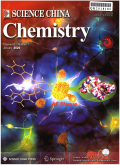- 钛学术文献服务平台 \
- 学术期刊 \
- 基础科学期刊 \
- 自然科学总论期刊 \
- 中国科学:化学(英文版)期刊 \
Electrochemical hydrogen-storage capacity of graphene can achieve a carbon-hydrogen atomic ratio of 1∶1
Electrochemical hydrogen-storage capacity of graphene can achieve a carbon-hydrogen atomic ratio of 1∶1
基本信息来源于合作网站,原文需代理用户跳转至来源网站获取
摘要:
As a promising hydrogen-storage material,graphene is expected to have a theoretical capacity of 7.7 wt%,which means a carbon-hydrogen atomic ratio of 1∶1.However,it has not been demonstrated yet by experiment,and the aim of the U.S.Department of Energy is to achieve 5.5 wt%in 2025.We designed a spatially-confined electrochemical system and found that the storage capacity of hydrogen adatoms on single layer graphene(SLG)is as high as 7.3 wt%,which indicates a carbon-hydrogen atomic ratio of 1∶1 by considering the sp3 defects of SLG.First,SLG was deposited on a large-area polycrystalline platinum(Pt)foil by chemical vapor deposition(CVD);then,a micropipette with reference electrode,counter electrode and electrolyte solution inside was impacted on the SLG/Pt foil(the working electrode)to construct the spatially-confined electrochemical system.The SLG-uncovered Pt atoms act as the catalytic sites to convert protons(H+)to hydrogen adatoms(Had),which then spill over and are chemically adsorbed on SLG through surface diffusion during the cathodic scan.Because the electrode processes are reversible,the Had amount can be measured by the anodic stripping charge.This is the first experimental evidence for the theoretically expected hydrogen-storage capacity on graphene at ambient environment,especially by using H+rather than hydrogen gas(H2)as the hydrogen source,which is of significance for the practical utilization of hydrogen energy.

推荐文章
The hydrogen and oxygen isotopic compositions of hydroxyl in clay mineral from a weathering profile:
Weathering profile
Hydrogen and oxygen isotopes
Hydroxyl
Kaolinite
Forest carbon storage in Guizhou Province based on field measurement dataset
Forest carbon storage
Field measurement dataset
Karst landform
Low carbon storage of woody debris in a karst forest in southwestern China
Secondary forest
Fine woody debris
Coarse woody debris
Dead wood
Karst
Subtropical China
Rare-earth and trace elements and hydrogen and oxygen isotopic compositions of Cretaceous kaolinitic
Rare-earth and trace elements
Oxygen/hydrogen isotopic composition
Kaolinitic sediments
Lower Benue Trough
Nigeria
内容分析
关键词云
关键词热度
相关文献总数
(/次)
(/年)
文献信息
| 篇名 | Electrochemical hydrogen-storage capacity of graphene can achieve a carbon-hydrogen atomic ratio of 1∶1 | ||
| 来源期刊 | 中国科学:化学(英文版) | 学科 | |
| 关键词 | |||
| 年,卷(期) | 2022,(2) | 所属期刊栏目 | COMMUNICATIONS |
| 研究方向 | 页码范围 | 318-321 | |
| 页数 | 4页 | 分类号 | |
| 字数 | 语种 | 英文 | |
| DOI | |||
五维指标
引文网络
引文网络
二级参考文献 (0)
共引文献 (0)
参考文献 (0)
节点文献
引证文献 (0)
同被引文献 (0)
二级引证文献 (0)
2022(0)
- 参考文献(0)
- 二级参考文献(0)
- 引证文献(0)
- 二级引证文献(0)
引文网络交叉学科
相关学者/机构
期刊影响力
中国科学:化学(英文版)
主办单位:
中国科学院
出版周期:
月刊
ISSN:
1674-7291
CN:
11-5839/O6
开本:
16开
出版地:
北京东黄城根北街16号
邮发代号:
创刊时间:
1950
语种:
eng
出版文献量(篇)
4060
总下载数(次)
0
期刊文献
相关文献
推荐文献
- 期刊分类
- 期刊(年)
- 期刊(期)
- 期刊推荐
力学
化学
地球物理学
地质学
基础科学综合
大学学报
天文学
天文学、地球科学
数学
气象学
海洋学
物理学
生物学
生物科学
自然地理学和测绘学
自然科学总论
自然科学理论与方法
资源科学
非线性科学与系统科学
中国科学:化学(英文版)2022
中国科学:化学(英文版)2021
中国科学:化学(英文版)2020
中国科学:化学(英文版)2019
中国科学:化学(英文版)2018
中国科学:化学(英文版)2017
中国科学:化学(英文版)2016
中国科学:化学(英文版)2015
中国科学:化学(英文版)2014
中国科学:化学(英文版)2013
中国科学:化学(英文版)2012
中国科学:化学(英文版)2011
中国科学:化学(英文版)2010
中国科学:化学(英文版)2009
中国科学:化学(英文版)2008
中国科学:化学(英文版)2007
中国科学:化学(英文版)2006
中国科学:化学(英文版)2005
中国科学:化学(英文版)2004
中国科学:化学(英文版)2003
中国科学:化学(英文版)2002
中国科学:化学(英文版)2001
中国科学:化学(英文版)2000

 免费查重
免费查重










